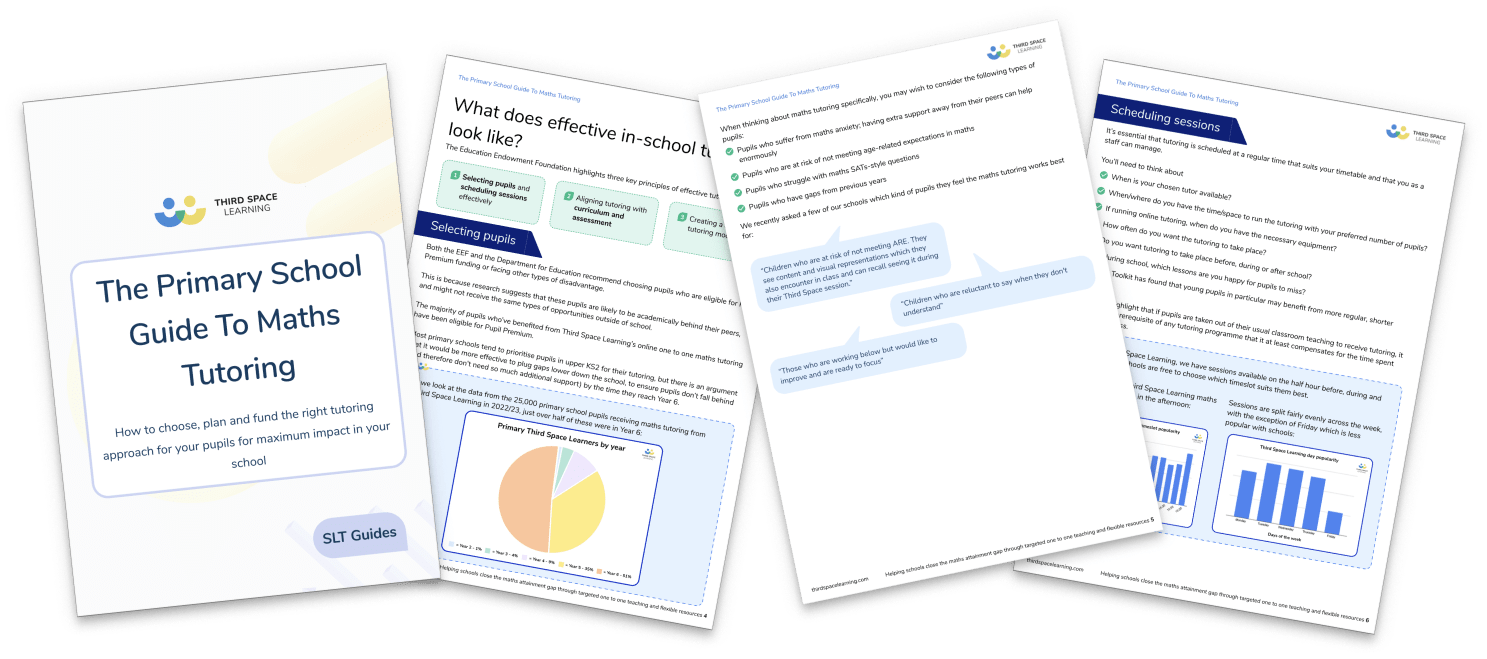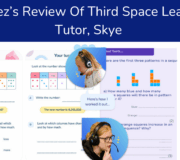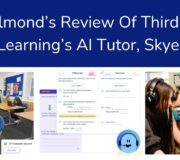A Guide To Primary School Tutoring For Teachers And School Leaders In The UK
Primary school tutoring is one of the most effective ways to raise attainment and close gaps in pupils’ learning. In recent years, more and more primary schools across the UK are embedding primary school tutoring into their intervention strategy, especially for English and numeracy.
If you are a teacher or school leader you may be considering introducing KS1 or KS2 tutoring for your primary school pupils. However, as with any approach or intervention, tutoring is not a silver bullet and there are many important decisions to make when designing and implementing your primary school tutoring strategy to ensure its success. This comprehensive guide aims to provide you with all the necessary information you need to make primary school tutoring a success in your context.
At Third Space Learning, we’ve been providing one to one tutoring to primary school pupils for 10 years. We’ve used our decade of experience providing in-school tuition and working with primary schools to develop this guide.
This article focuses on in-school primary school tutoring and is aimed at teachers and school leaders, as opposed to parents looking for private tuition and home tutors.
Why consider primary school tutoring?
Schools implement primary school tutoring for many reasons, all of which centre on the progress of pupils in their schools who need extra support outside of their mainstream lessons. Here are some of the more specific reasons:
- Target and address individual gaps and misconceptions: In the aftermath of Covid-19 and the resultant school closures and disruptions to teaching, many pupils have considerable gaps in their learning. If these gaps are left unaddressed, children risk falling further behind.
This is especially true for subjects such as maths, which is cumulative, meaning concepts build on each other and rely on prerequisite skills. A pupil who has not grasped foundational concepts in maths will struggle to keep up with their peers, and gaps in learning will escalate. If possible, it’s best to address these gaps early. It will be too late when pupils are in Year 11 taking their GCSEs! - Adapt pitch and pace of delivery to suit pupils: Even in well-planned and well-delivered lessons, it can be challenging for a class teacher to give every child the personalised support they may require in a class of 30. Tutoring, especially one to one tutoring, offers the opportunity to support learners on an individualised basis and any special educational needs or adjustments.
- Drive engagement and confidence: Many pupils can feel self-conscious in whole class environments and feel discouraged to ask for help or answer questions at risk of making mistakes. Small groups and one to one tutoring offer pupils the opportunity to make mistakes in a low stakes, nurturing learning environment away from peer pressure.
Read more: Maths anxiety - Support disadvantaged pupils: The EEF found that providing pupils with one to one support for a particular subject is very effective at improving pupil outcomes, especially for pupils who are eligible for free school meals.
With regards to Pupil Premium funding, schools are held accountable for how they spend their funding and their strategy to support the disadvantaged pupils in their care. Tutoring is a well-evidenced strategy to support pupils and can show a clear impact on student progress.
Read more: Tutoring disadvantaged students - Prepare students for secondary school and beyond: Primary school tutoring can help students prepare for the transition to secondary school. It can close any gaps in their primary education that would otherwise hold pupils back in their learning. It can also support students to develop the knowledge and skills required for their Year 6 SATs or entrance exams.
As a school leader, once you’ve decided that primary school tutoring is the right approach for your school, there are still many factors to consider before you start.
Let’s look at each one in turn.

Meet Skye, the voice-based AI tutor making maths success possible for every student.
Built by teachers and maths experts, Skye uses the same pedagogy, curriculum and lesson structure as our traditional tutoring.
But, with more flexibility and a lower cost, schools can scale online maths tutoring to support every student who needs it.
Watch Skye in actionWhich type of tutoring is right for your school?
The biggest decisions you will need to make before starting up primary school tutoring are:
- Online vs. In person tutoring
- One to one vs. Group tutoring
- Internal vs. External providers
Below, we looked at each decision in more detail.
The Primary School Guide to Maths Tutoring
How to choose, plan and fund the right tutoring approach for maximum impact in your school.
Download Free Now!Online tutoring vs in person tutoring
Online tutoring is an increasingly popular option for schools. Online tutors work exactly like other tutors, but the lessons take place over programs like Skype, Zoom or an online classroom instead of in-person.
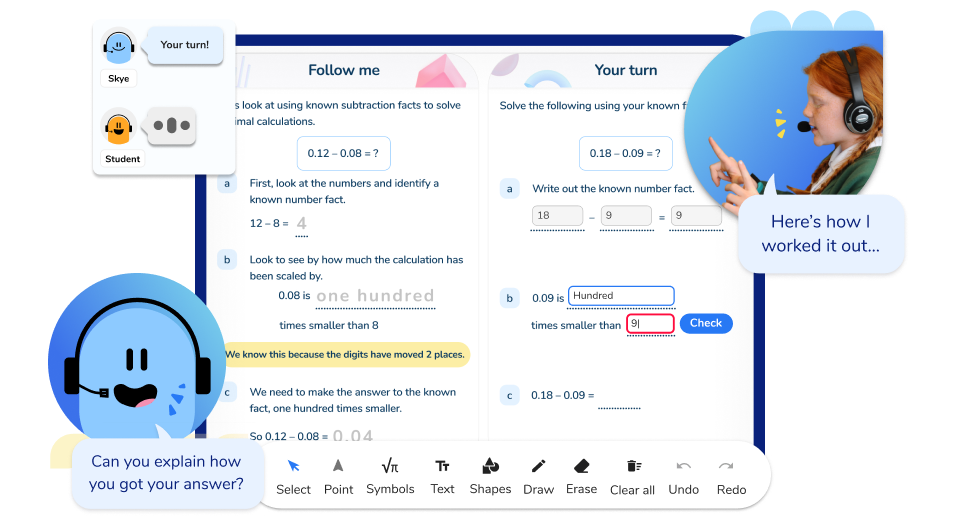
Third Space Learning’s online classroom has been designed with maths teaching in mind – it has an easy-to-use interactive whiteboard and quick click buttons to generate mathematical symbols. Our online AI maths tutor has a library of high-quality curriculum-aligned materials to support students. See how it works in action here.
Research has found that face-to-face person tutoring offers no significant benefit over online teaching and the effects of both are similar. It therefore comes down to the needs and preferences of your context. See the tables below for a summary of the strengths and weaknesses of online and in-person tutoring. If you’re already convinced that online is right for your school, read this review of the best online maths tutoring platforms.
Online tutoring
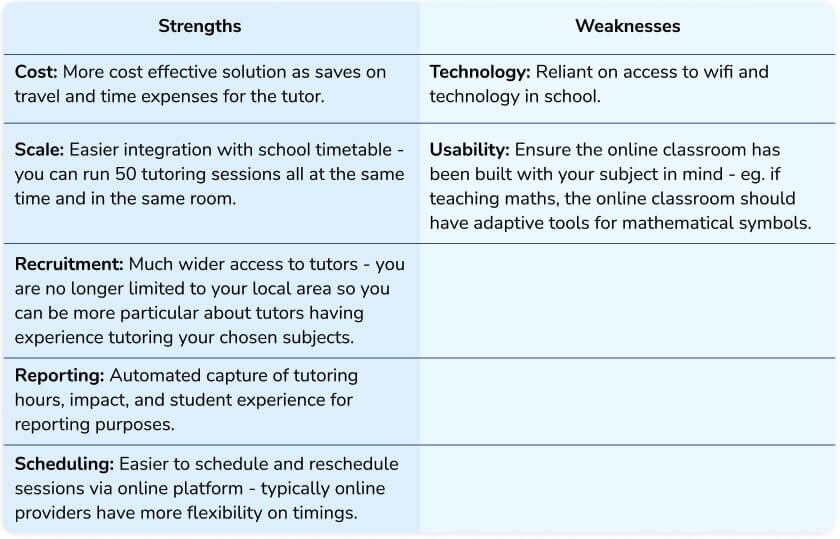
In person tutoring
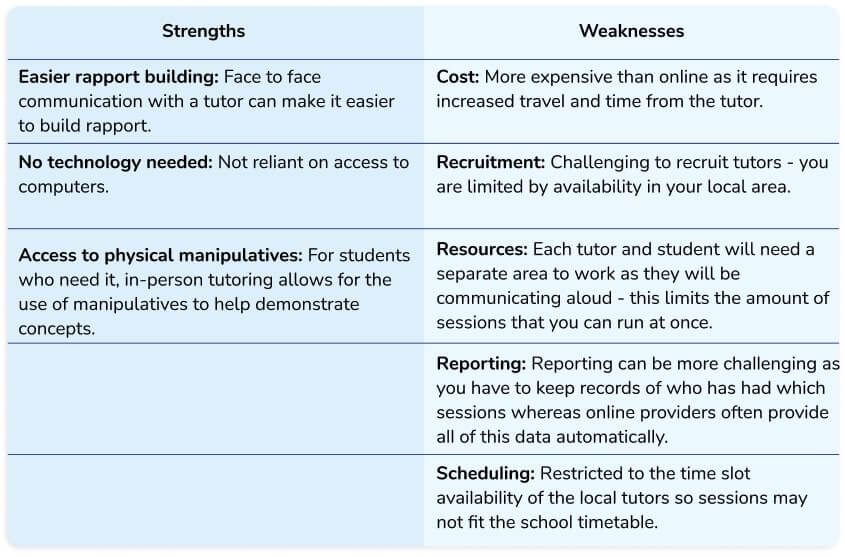
Read more: Benefits Of Online Tutoring Vs In-Person Tutoring
One to one vs group primary school tutoring
The more personalised and focused on individual learning gaps a tutoring session is, the more impact it will have on pupil progress. It’s for this reason that research suggests that one to one tuition is the best approach, especially for pupils identified as having low prior attainment.
Small group tutoring can offer personalised learning but will require complex student matching to group pupils who share learning gaps and areas for support. This requires careful planning, sensitive diagnostic assessment and more highly trained staff with tutoring experience as it is more challenging to deliver. This can be challenging for schools to hire the right staff, particularly in rural areas and for subjects such as maths and science that already face specialist shortages.
Traditionally, one to one tutoring is expensive to deliver, however, online one to one tutoring combats this as tutors have lower overhead fees. For example, by taking tuition online, schools choosing Third Space Learning benefit from personalised, one to one tuition for roughly one third of the cost of traditional one to one tutoring.
Internal vs external primary school tutoring providers
There are many benefits to opting to run your tutoring sessions with internal staff. If they are existing staff, they will likely already have established relationships with your pupils and find rapport-building easier.
However, you need to be mindful of adding to the already stretched teacher workload. The most effective tutors will be subject specialists and qualified primary school teachers.
Where schools choose to use staff who might not be maths specialists, research from the Education Endowment Foundation suggests that they will be most successful when they have several years of experience, are well-trained and supported – for example, delivering a structured intervention. This can be costly and require significant CPD time.
External providers can alleviate some of these pressures. Advantages of an external intervention include:
- Reduced impact on staff workload
- Management of tutoring, hiring and training
- Monitoring and reporting
- More ratings and reviews
Through the National Tutoring Programme, schools in England can work with quality assured external tuition partners. Third Space Learning is proud to have been an official Tuition Partner with the NTP since it first launched in 2020.
Read more: Best online tutoring websites
What else should you consider when choosing between the different primary school tutoring options?
Once you’ve made the key decisions about the approach that is best for your school’s context, you will need to consider the following.
Cost
When evaluating the cost of primary school tutoring, it’s important to look beyond the initial fees quoted by tutors or agencies. Consider the following cost-related factors:
- Pricing structure: Determine whether the pricing is based on an hourly rate or a per-lesson rate.
- Additional costs: Inquire about any additional costs, such as transportation expenses or fees for supplementary materials.
- Session duration and frequency: Understand the length of each tutoring session and how often the sessions will occur. Consider if the options available to you are complementary to the needs of your students. For example, younger pupils are more likely to benefit from more regular, shorter sessions.
- Impact: While considering cost, remember to choose cost-effective options. Whilst group tutoring may have lower start-up costs, it is less effective than one to one tutoring and you may need more sessions for longer to see the progress you need.
By considering these cost-related factors, you can make an informed decision that aligns with your school’s budget and your students’ needs.
If you are opting to deliver tutoring using internal staff, it is still important to consider the cost involved in staff salaries, resources and training – especially if it is delivered by non-subject specialists.
In the case of maths, research from the Education Endowment Foundation suggests that non-maths specialist run interventions will be most successful when they are ‘experienced, well-trained and supported – for example, delivering a structured intervention.’ However, this can be costly.
Scheduling
Different tutors and companies have very different session lengths. It’s important to know session length and frequency.
Research suggests that a 12-15 week programme is most effective for raising attainment. In our experience as tutoring providers, session lengths of around 45 minutes once a week are optimal to maximise fluency and retention, while giving time for exploration and greater depth.
As you know, life in primary schools is busy. With school trips, unexpected absences, visitors and assemblies, there’s never a dull moment. But this means you’ll want to choose a primary school tutoring provider that understands the needs of your school and builds flexibility into their programme.
As in-school tutoring specialists with over a decade of experience, Third Space Learning understands what school leaders need. We offer schools slots throughout the school day, with the flexibility to schedule them up to every 5 minutes, or the option to launch on-demand sessions.
Every school enrolled in Third Space Learning’s tutoring has a dedicated account manager who supports the initial set-up and running of their tutoring sessions. They’re on-hand to support the scheduling and to troubleshoot any issues.
Workload
It is important to choose primary school tutoring options that do not add to teachers’ stretched workloads.
This is why opting for external tutoring providers may be the right decision for your school, as many will take care of the administrative tasks involved in primary school tutoring, such as:
- Recruiting tutors
- Initial diagnostic assessment
- Designing bespoke learning programmes for students
- Selecting lessons
- Monitoring and reporting
- Scheduling and timetabling
Quality and impact
Whichever form of tutoring you choose for your school, you want to be sure it’s of the highest quality. The best way to ensure this is by choosing well-evidenced approaches delivered by qualified, experienced tutors.
However, it can be challenging to recruit specialists for subjects such as maths and science, especially for schools in rural areas. Going online can help overcome this challenge as you have a wider pool of tutors to choose from.
Nevertheless, recruitment can be a time-consuming task. Choosing to work with an external tutoring provider such as Third Space Learning will help to shortcut this with AI tutor Skye, who is:
- Trained by qualified teachers and maths specialists, thus replicating the subject expertise;
- Uses a non-judgmental tone every lesson to help learners build confidence;
- Built on over a decade of maths tutoring expertise and pedagogy;
- Naturally safeguarding pupils by raising red flags, no DBS checks required for multiple tutors.
Another benefit of choosing to work with external providers is that you will be able to read online reviews and case studies of schools like yours to inform your decision. You may even be able to watch sessions in action so you know exactly what to expect from a tutoring company. You can see an example of a Third Space Learning session here.
Curriculum
Tutoring is most effective when it is aligned with whole-class teaching. When reviewing tutoring curricula, use your professional judgement to ensure that it reflects the way your pupils will be learning so that they can reinforce their learning from tutoring sessions in their classroom practice and schoolwork. Additionally, the EEF found that tutoring is most effective when it is targeted and makes use of diagnostic assessment.
Third Space Learning’s primary curriculum is aligned with the national curriculum and is designed by former UK teachers and pedagogy experts, and has full coverage of all Year 4-6, with a dedicated SATs tutoring programme for Year 6 pupils.
Every maths intervention lesson begins with a short diagnostic assessment called the “Skill Check In” to identify the pupil’s baseline knowledge and adapt the lesson pathway in real-time.
If the pupil is not yet secure in their understanding, Skye will scaffold slides to teach the concept step-by-step. Skye models a similar example and works through questions together with the pupil before they move on to independent practice and challenge. If the pupil shows they’re ready, Skye will skip straight to the application and challenge section of the lesson.
Throughout, Skye uses formative assessment to identify misconceptions and adapt hints accordingly. Every lesson ends with a short summative assessment, the “Skill Check Out” to check the pupil’s understanding and track progress over time.
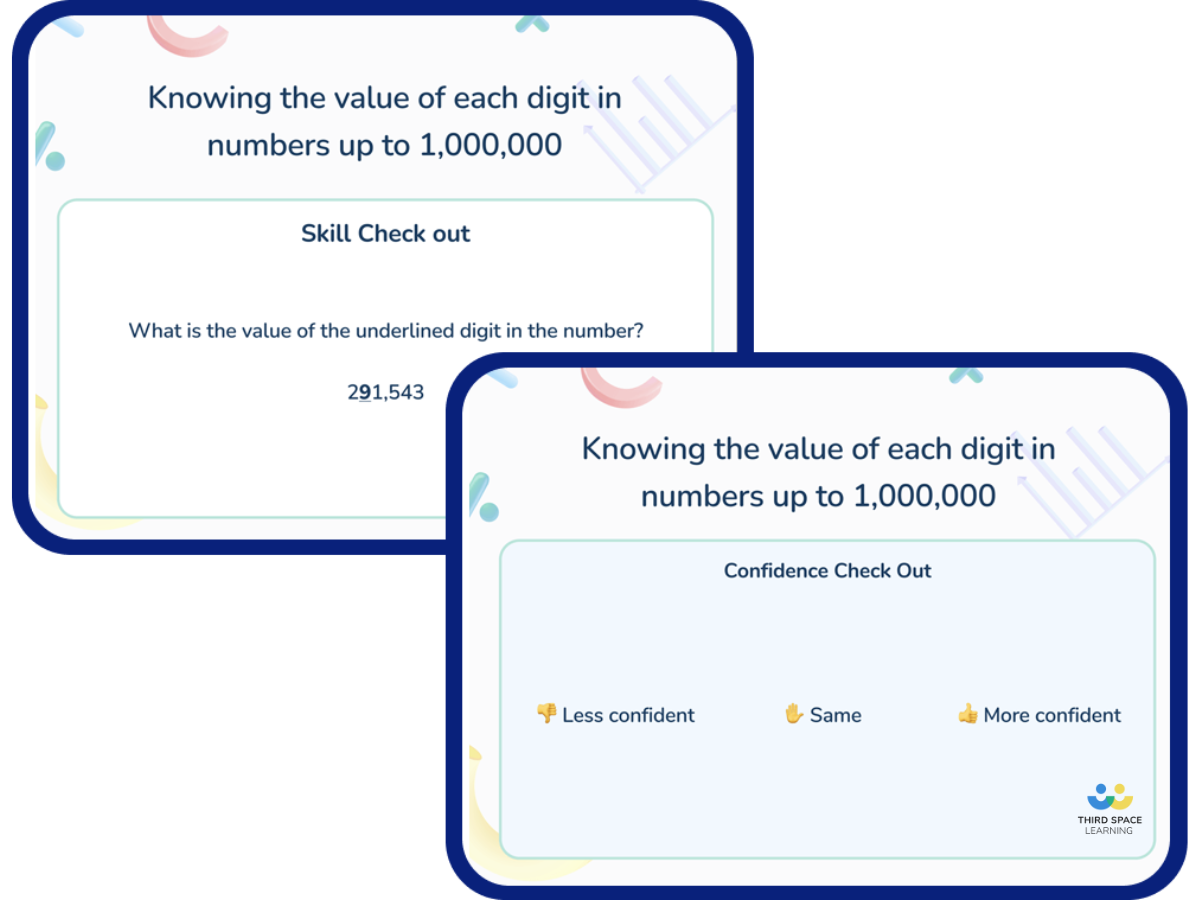
Reporting and monitoring
In order to assess the success of your primary school tutoring, it’s important that you have access to the necessary data. This can be time-consuming to collect yourself, so look out for tutoring providers who will do this for you.
At Third Space Learning, teachers have on-demand access to post-session reports detailing pupils progress.

5 tips to ensure success through your primary school tutoring strategy
Once you’ve decided on the approach to primary school tutoring that best suits the needs of your school, there are several actions you can take ahead of the first session to set it up for the best chances of success. You will also need to establish processes to monitor and evaluate the tutoring sessions. This will help you to track progress and refine your approach over time. Through this, schools can create a sustainable tutoring model that makes a real impact on the pupils who need it most.
Here are five tips to help you both with the initial set up and ongoing success of primary school tutoring in your school.
1. Prepare your pupils for their primary school tutoring sessions
Even before sessions begin, teachers can prepare students for their tutoring sessions by setting expectations around attendance, behaviour, engagement and more even before their first class.
The dynamic in small group tutoring and one to one tutoring is very different from whole class teaching, so pupils, especially young children, may need support when adjusting to this new learning style.
As teachers, you’ll already be well aware of the positive impact of parental involvement. Research consistently shows that when parents are involved in their child’s education, it not only has a positive impact on academic achievement but also attendance, behaviour and children’s social and emotional development.
Share information about tutoring sessions with parents and carers, especially if sessions are scheduled before or after school and will require parents to pick up or drop off their child at a different time.
2. Organise the logistics ahead of the first session
Planning is key to successful implementation of primary school tutoring.
Ensure you have a clear understanding of:
- Staffing
- Timetabling
- Location (suitable room with necessary equipment)
- Resources required (e.g. textbooks, technology, manipulatives, etc.)
- Curriculum
- Reporting and attendance
If you’re working with an external provider, they will likely support many of these considerations, reducing your workload.
If you’re opting for online tutoring, it’s important you check the connection and technology requirements ahead of your first session.
For schools working with Third Space Learning, their dedicated account managers are on hand to guide them through the initial set-up.
3. Ensure tutors take time to establish positive relationships with students
Positive relationships between tutors and students is more than a ‘nice to have’. It’s foundational in creating positive learning environments where students feel supported, motivated and engaged.
Each tutor will have their own strategies to build relationships, but it’s important that this is considered and built into their tutoring approach.
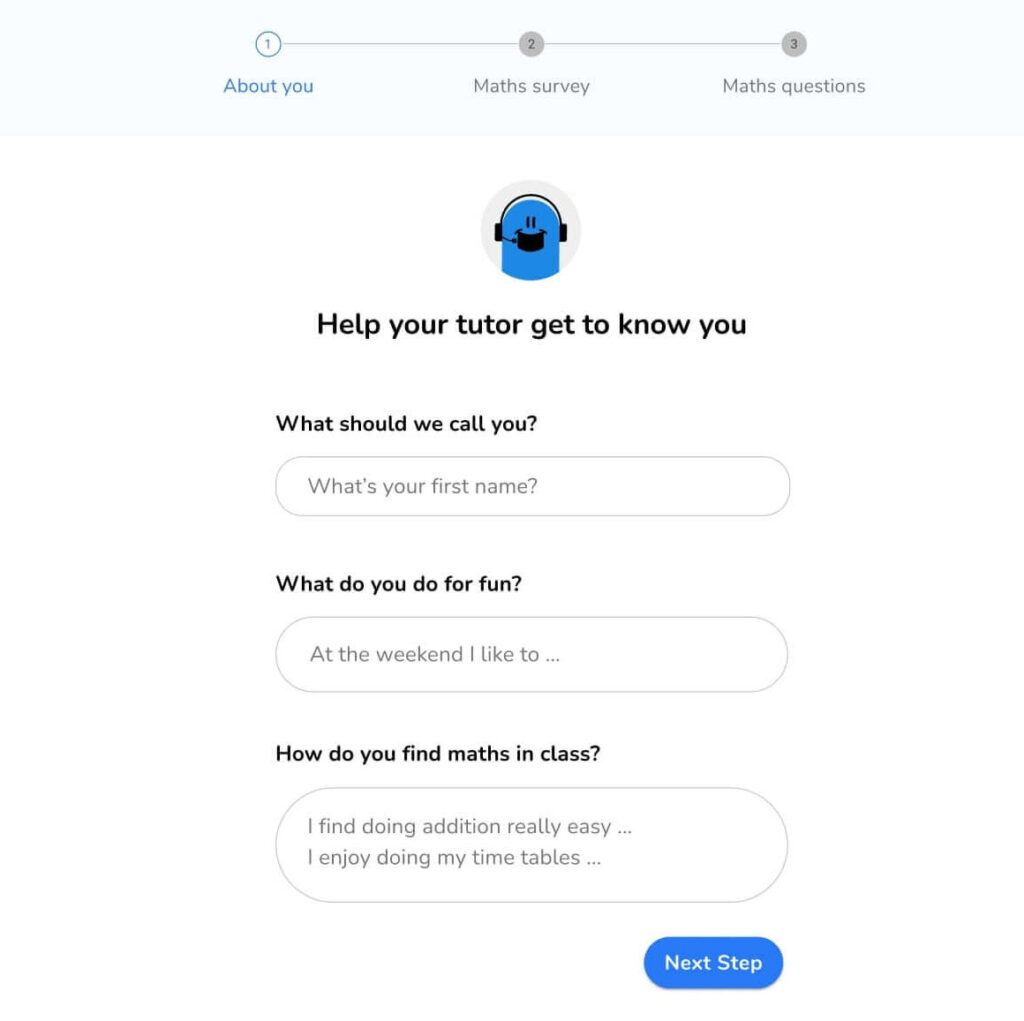
4. Prioritise targeted and focused primary tuition
The EEF found that tuition is most effective when it is targeted at pupils’ specific needs. This will require sensitive diagnostic assessment, such as quizzing, questioning and assessment. This should occur not only at the initial stage, but occur throughout the tutoring sessions.
5. Monitor progress regularly
In order to evaluate the effectiveness of your approach and to make any necessary adjustments, you’ll need to monitor progress regularly.
For example, teachers using Third Space Learning have access to on-demand individual pupil progress reports which detail:
- The lesson objectives pupils have completed;
- What they have struggled with;
- What took longer to complete.
These can easily be downloaded, printed and shared with parents or colleagues in a matter of minutes.
It’s about what approaches result in the biggest impact on pupils
In the end, all of these considerations and tips are aimed towards one simple thing: making sure your pupils make good progress.
Every school will have different needs and requirements, which is why there is no ‘one-size-fits-all’ approach to effective tutoring. It’s all about using the research to guide your initial decisions and using effective monitoring to make the adjustments needed.
There are many approaches tutors can take to tutor a primary school student. One of the most important things to do begins before the first session – use a diagnostic assessment to decide what content needs to be covered in tutoring sessions. This information can also be used to track and show pupil progress so you can be sure tutoring is having a real impact on student outcomes and, if not, implement changes to improve it.
There is no right or wrong age to start tutoring. However, private tutors working with early years pupils will likely struggle to engage them and keep them focussed. From 5 years old, pupils may be able to work with tutors on a one to one basis. Some people say tutors are unnecessary until pupils reach secondary school and higher, however we find that starting during primary school helps to close gaps early, before they widen.
The best tutors are likely to be those with a background in teaching and education, such as a PGCE. However, you don’t need any specific qualifications to be a primary school tutor. You should have a strong understanding of the subject you are tutoring and a positive approach to teaching and learning.
The EEF found that when non-specialists were used as tutors, such as teaching assistants or volunteers, the outcomes were best when they had training and followed a structured programme.
DO YOU HAVE STUDENTS WHO NEED MORE SUPPORT IN MATHS?
Skye – our AI maths tutor built by teachers – gives students personalised one-to-one lessons that address learning gaps and build confidence.
Since 2013 we’ve taught over 2 million hours of maths lessons to more than 170,000 students to help them become fluent, able mathematicians.
Explore our AI maths tutoring or find out about online maths tuition for your school.



